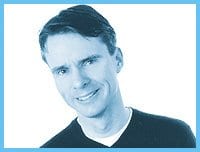Big money is moving into gay programming. The American networks Showtime and MTV, both owned by Viacom, are thinking of starting a gay network.
As part of the massive media empire, the American venture will almost certainly have far deeper pockets than Canada’s PrideVision. But money or no money, neither PrideVision or its American rival can count itself fully gay until it fills one glaring gap in its programming.
Figure skating.
Forget porn, drag and Sex And The City. Male figure skating is the gayest thing on TV. With its astonishing mix of earnest emotion and flagrant camp, how could it be otherwise?
“But, but, but,” I hear you say, “what about Elvis Stojko?” Yes, I know. Unfortunate wasn’t it? For seven years, ever since he won the Canadian men’s title in 1994, the helmut-haired hero of Richmond Hill has allowed Canadian parents to delude themselves into thinking little Johnny’s interest in triple axels and expressive arm movements was a natural extension of his, ah, athletic ability.
Look at Elvis, no pretty boy there. Butcher than your average biker. Coming after the flamboyant likes of Toller Cranston, Stojko was the earnest, hardworking, Little Straight That Could.
To everyone else, he’s the exception that proved the rule.
Men’s figure skating is the most closeted sport around, but also the most obviously gay and the paradox is an inescapable part of its appeal. Watching a skating competition is like watching a drag show and being told that the guys in wigs are straight. Rainbow Ice, a website devoted to gay skating, lists 20 elite gay skaters, eight of them dead, one a choreographer, none of them still competing at the level where reputations are made, the amateur.
Yet skating is gay to its core.
“Figure skating is the official Olympic sport of the gay community,” wrote writer/critic Brian Fawcett in 1997. “That this is common knowledge and that one-million Canadians will watch any televised figure skating event television networks run probably testifies more accurately to the degree of pre-conscious acceptance of homosexuality than the more official legal benchmarks sought by gay activists.”
For skating’s camp appeal you need look no further than the music, which never strays far from overwrought film scores or heart-on-its-sleeve romanticism. For giggle-making kitsch, just check out the costumes. Some of the Canadian pairs and dance couples have struggled to bring a modicum of good taste to the sport, but most of the men have fought that unnatural trend with full-bore flamboyance.
Plunging necklines, oversized collars and even the occasional set of chiffon wings – male skaters all seem to be trying out for a Vegas floor show. At the Canadian championships in Hamilton in January, the usually dashing Emmanuel Sandhu wore a cummerbund and vest affair that made him look like a Tyrolean yodeller auditioning to work with Siegfried and Roy.
Yet it’s impossible to make fun of skating for long, if only because it tells a heart-warming story. Gay culture is often considered the very essence of cynical sang froid, but from the novels of Michael Cunningham (The Hours) to drag imitations of Diana Ross, there’s another, warmer side to the tradition. Skating exemplifies the best of it.
Skating is the big gooey heart of gaydom, the place where the bitchery leaves off and the romantic in all of us comes gushing forth.
Straight or gay, male skaters play a gay role. The minute they step on the ice, they enact the familiar story of the sensitive but athletic lad in search of public acceptance.
Each four-and-a-half minute free skate is a mini-novel of trial and redemption, a icy version of “I Will Survive,” wherein our hero endures various trials (those tricky triple jumps) and emerges unscathed, heart on sleeve, to receive the accolades of the crowd.
This is the one sport where the gay boy always wins. He can wave his wand-like arms faster than Tinkerbell at a Judy Garland concert and still get a standing ovation from a crowd full of middle-Canadians. Win or lose, he’s “out” there.
The story faltered in the face of Stojko’s machine-like machismo, but the newer skaters exhibit sufficient vulnerability to play the role with style. Many of them will be on view during the winter games in Salt Lake City beginning Fri, Feb 8 (being broadcast on CBC). It should be fun to watch this archetypal gay story play itself out at what some people are already calling the Mormon Olympics.
Don’t sweat the technical details. Follow the fairy tale on ice.

 Why you can trust Xtra
Why you can trust Xtra


